From inside (document excerpt):
Models 15300 15301 15500 15501 SAFETY PRECAUTIONS WARNING! To prevent personal injury, Wear goggles when working with refrigerants. Contact with refrigerants may cause injury. Incorrect use or connections may cause electrical shock hazards. Read and follow the instructions carefully, and take precautions to avoid electrical shock hazards. Confirm that all associated devices are grounded correctly before energizing circuits.
Power Tool User Manual Free Download. HAVC Operator’s Manual. Auto AC Lift Power Free Instruction Manual Download PDF.
Normal operating temperature will cause certain external portions of the pump to be hot to the touch. Do not touch the pump housing or motor during operation. For use on A/C-R systems using CFCs, HCFCs, and HFCs in conjunction with mineral oil, ester oil, alkylbenzene oil, and PAG oil as lubricants. Not for use with ammonia or lithium bromide systems. Not for use with flammable refrigerants. VacuMaster® High Performance Vacuum Pumps Congratulations on purchasing one of Robinair’s top quality VacuMaster® vacuum pumps. Your pump has been engineered specifically for air conditioning and refrigeration service, and is built for fast, thorough evacuation. You’ll appreciate these key features. High Vacuum Rating Lifetime Filtration Sure-Grip Handle Compact Design The two-stage rotary vane design provides powerful, quiet, high vacuum capability and ensures moisture removal, while the high pumping capacity reduces evacuation time. The intake screen prevents foreign matter from entering the pumping chamber, and an internal exhaust filter separates oil vapor from the exhaust flow. The one-piece, molded handle makes it easy to carry the pump to and from job sites, and the handle stays cool to the touch during operation. Aluminum housing and rotary vanes keep the pump weight low, making it easy to carry. Models 15300 & 15500 Handle & Switch Assembly Gauge Capacitor (under handle) Oil Fill Plug Base Housing Gasket (not shown) Solenoid Inlet Fitting Models 15301 & 15501 Exhaust Fitting Sight Glass Oil Drain Fitting Inlet Fitting Adapter (included but not shown). 556679 Rev. C, February 28, 2011 1 Before using your vacuum pump. Note about Motor Voltage Connections: In all cases, motors are designed for operating voltages plus or minus 10% of the normal rating (see Pump Specifications). Single voltage motors are supplied fully connected and ready to operate. 1. Confirm that the voltage and frequency at the outlet match the specifications on the pump motor decal. 2. Confirm the ON-OFF switch is in the OFF position before you plug the pump into an outlet. 3. Remove and discard the exhaust plug from the exhaust fitting. 4. The pump is shipped without oil in the reservoir. Before starting the pump, fill it with oil. Remove the OIL FILL cap (red plastic plug at the front of the handle), and add oil until oil appears in the bottom of the sight glass. For oil capacities, refer to Pump Specifications in this manual. 5. Replace the OIL FILL cap, and remove the cap from one of the inlet ports. 6. Turn the motor switch to ON. 7. When the pump runs smoothly, replace the cap on the inlet port. This may take from two to 30 seconds, depending on the ambient temperature. 8. After the pump has run for approximately one minute, check the sight glass for the correct oil level — oil should be even with the sight glass OIL LEVEL line. With the pump off, add oil if necessary. Note: When the pump is running, the oil level should be even with the line on the sight glass. Underfilling the pump will result in poor vacuum performance; overfilling can result in oil blowing from the exhaust. Your pump is now ready to evacuate air conditioning and refrigeration systems. Follow normal service procedures and the A/C-R manufacturer’s instructions for connections to the system. CAutION: Before connecting your vacuum pump to an A/C-R system, remove refrigerant from the system in an accepted manner. Damage to the pump may occur if evacuation is started while the system is under high pressure. Robinair recommends the use of its Refrigerant Recovery and Recycling equipment. 2 to shut down the pump after use. 1. Close the manifold valve between the pump and the system.


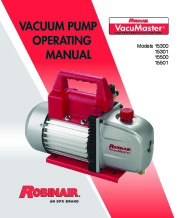 Robinair SPX Models 15300 15301 15500 15501 Owners Manual - Enlarge page 1 of 12
Robinair SPX Models 15300 15301 15500 15501 Owners Manual - Enlarge page 1 of 12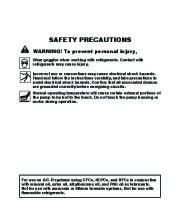 2 of 12
2 of 12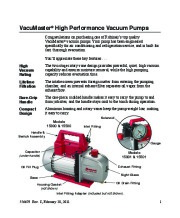 3 of 12
3 of 12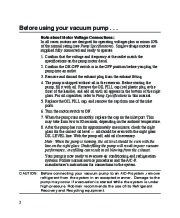 4 of 12
4 of 12 5 of 12
5 of 12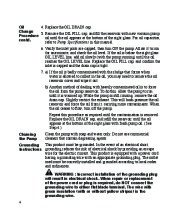 6 of 12
6 of 12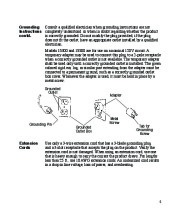 7 of 12
7 of 12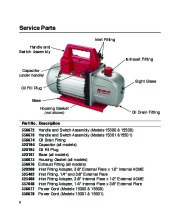 8 of 12
8 of 12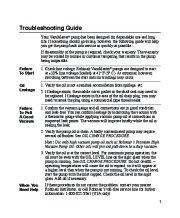 9 of 12
9 of 12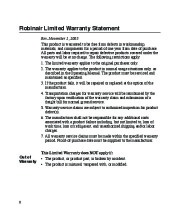 10 of 12
10 of 12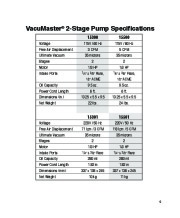 11 of 12
11 of 12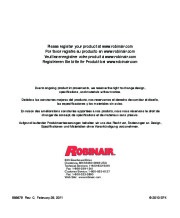 12 of 12
12 of 12